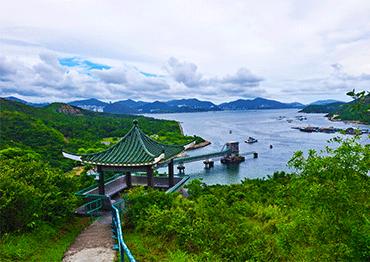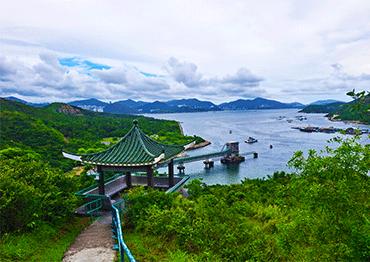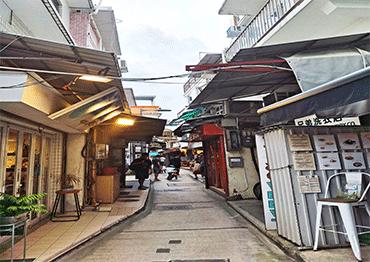Hong Kong is a dynamic and creative city, centered around a vibrant and bustling island. At times, the city can provide a unique rush of energy. It can be empowering, exciting and exhilarating. However, the dense city center also has the ability to drain you of all your energy, especially on an oppressively hot summer’s day. That is why it is so fortunate that visitors and residents in Hong Kong are able to swiftly escape the mayhem of the skyscrapers and find tranquility on one of the many islands within Hong Kong’s tropical territorial waters. First time visitors are often drawn to Lantau Island, the biggest island, but those seeking respite would be better off taking a ferry to the serene Lamma Island, the Special Administrative Region’s third-largest island.
Lamma Island’s peaceful atmosphere is in no small part thanks to deliberate conservation efforts by locals. Buildings more than three stories high are banned, while the island is free of automobiles other than zippy two-wheeled vehicles for essential activities. These rules and regulations help to preserve Lamma as an oasis of calm, just a short ferry journey away from the cacophony of traffic and construction. The island is easily accessible via two ports. The larger port, Yung Shue Wan, enjoys access to a ferry service approximately every 30 minutes, while the smaller port, Sok Kwu Wan, receives multiple services each day.
Lamma island is crisscrossed by walking trails. Although the island features small hills, some of the trails can be steep, but the views at the top can make up for that. Of major relief to those who visit the island during the summer when temperatures are sweltering is the chance to stop at some of the island’s beaches along the way for a cooling dip or paddle. One of the most popular trails guides visitors from the small settlement of Sok Kwu Wan to the island’s primary settlement, Yung Shue Wan. This five-kilometer route, called the Family Trail, with short, steep climbs, has a number of advantages, starting and ending at ferry ports with access to restaurants and other amenities. Between the two ports, the walking trail passes numerous beaches, hamlets, viewing pagodas and even some “kamikaze” caves that were built during World War II to store explosives.
Although Sok Kwu Wan is the second biggest settlement on the island, it is significantly smaller than Yung Shue Wan. In essence the settlement is a one-street fishing village. The street itself is dominated by seafood restaurants and shops selling tourist nick-nacks, while the adjacent harbor is dominated by small fishing boats. Sok Kwu Wan is much quieter than Yung Shue Wan, and offers a convenient place for visitors to rest, drink a cold beer, or eat some freshly caught fish. However, the scenery is of only limited interest and the village offers significantly limited choice compared to its bigger neighbor. That may explain why the majority of people disembarking the ferry stop only in Sok Kwu Wan to purchase snacks, water and walking necessities before heading off into the forest or along the coastal paths.
Once visitors reach Yung Shue Wan they are greeted by an entirely different environment. Despite its limited size, there are an abundance of restaurants, bars, shops and facilities. Perhaps due to its accessibility from the center of Hong Kong, the town has a thriving multicultural resident population, and has cultivated a relaxed and liberal atmosphere. As well as plenty of restaurants that offer Chinese dishes and fresh seafood, there are restaurants selling Thai, Middle Eastern, Mexican and Indian cuisine, juice bars, coffee shops, bars selling Western snack foods including vegan options, and sophisticated European-style restaurants. Many of the nicer establishments have built extensive decks to allow al fresco dining and drinking overlooking the harbor.
However, not every Hong Kong resident speaks glowingly about visiting Lamma Island, and many of them will qualify their endorsement with slight caution. One of the controversial dimensions to any Lamma Island visit is the gargantuan power plant that dominates the north of the island. For some visitors, the power station is an eyesore, which destroys the natural landscape. For others, the monumental chimneys, which tower over their surroundings, provide an almost surreal quality to the area. Indeed, the juxtaposition between natural serenity and industrial obscenity is fascinating, and results in many artistic creations by photographers, painters and sculptures.
This contrast is exacerbated by the abundance of wildlife, which thrives on Lamma, despite the industrial presence. Visitors can spot birds of prey, and a cornucopia of marine and insect life. However, perhaps the most famous are the giant golden orb weaver spiders, sometimes called giant wood spiders. These arachnids were, until a new species was recently discovered in Southern Africa, considered to be the largest orb weaver spiders on the planet. They build extensive webs between tree branches and buildings, and are ever-present on walking trails. However, it is rare one will bite a human, and the bites are not considered to be particularly dangerous, so apart from occasionally causing visitors to jump with surprise, their presence is of no concern.
Other wildlife to be spotted by patient and observant visitors includes the common mudskipper, the common kingfisher, the bamboo pit viper, the large-spotted cat snake, the brown tree frog and the endemic Romer’s tree frog. Romer’s tree frogs are endangered and only exist in Hong Kong, and a very small part of Guangxi Zhuang Autonomous Region on the Chinese mainland. The species was first discovered on Lamma Island in 1952, and although it was believed to be long extinct, it was rediscovered in 1984. Sham Wan Beach in the south of the island is the only nesting beach for green turtles in Hong Kong. To protect the population, the beach is off limits to visitors between June and October, under threat of a significant fine. Nevertheless, despite the conservation efforts, there has been no documented nesting by green turtles on the beach since 2012.
In reality, Lamma Island does not resemble a stereotypical tropical island fantasy paradise. However, for everything that the island lacks, it offers something exceptionally unique. Lamma Island offers a quick and convenient escape from one of the world’s biggest metropoles, while allowing visitors to access abundant conveniences including diverse cuisines. Lamma Island also offers visitors the chance to walk in nature, see rare wildlife, and still have quick access to an iced latte. That is why Lamma Island is a perfect escape from Hong Kong.

 Old Version
Old Version

